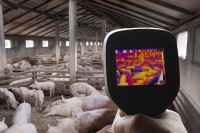High feed prices, inflationary pressure and supply chain disruptions to be common themes again in 2022

Meat prices are likely to increase in Q2 this year, hopefully resulting in decent profitability again in farming, according to Jan Kamphof, regional director, EMEA, Grady Fain, VP sales and regional director, North and Central America, and Yu Feng, regional director, APAC, at Hamlet Protein.
Feed volumes are expected to remain under pressure, while inflationary pressure will persist and possibly increase, they forecast.
The cost of feed will continue to be a headache for nutritionists and producers, with the poultry industry, in particular, extremely sensitive to feed price volatility, compared to other animal protein production segments, they said.
Supply chain disruptions
The Hamlet Protein representatives also anticipate ongoing disruptions to the supply chain linked to COVID-19 with little let up in the high freight costs we saw in 2021.
Comments from Ryan Smith, global supply chain senior director, Novus International, Inc, tallied with that view.
The challenges this year, he said, will continue to be “those things we can’t control – the ongoing pandemic with its complications and disruptions, particularly concerning supply chains.”
Feed ingredient suppliers globally have had to address incredibly long lead times, exorbitant shipping costs, labor shortages, and unprecedented demand for packaging components since the pandemic began, he said.
This latest rise in COVID-19 cases is a reminder that the virus and its variants aren’t going away and neither are the pandemic-related problems, continued Smith.

“It’s vital that those working on supply chain and logistics teams be provided the tools and authority to adapt their strategic focus from what is likely a cost-saving model to a stability model. This is what Novus has done, reviewing our business continuity plans to account for the repeated challenges we’ve faced since March 2020.
“We’ve worked to broaden our supplier base, more closely align demand planning with customers and suppliers, alongside that, we’ve implemented near-sourcing, and made internal changes that can also make a big difference in being able to effectively mitigate challenges and address disruptions efficiently,” added the Novus representative.
Adriano Marcon, president of Cargill’s animal nutrition business, also talked about the ways the company managed to get around supply chain challenges last year.
"In 2021, we were able to adjust the supply chain, find alternate sources, move ingredients and commodities across borders and find creative shipping solutions, to deliver against customer contracts. Just like the consumer, we have some customers that might not be able to get the exact product in the exact size, but we have avoided shutdowns and significant delivery issues."
Hamish Irving, global marketing director, Danisco Animal Nutrition, expects ongoing impacts from COVID-19 on supply chains and the ability of all businesses to operate. "It may get worse before it gets better with Omicron."
The company, he said, sees the need for more sustainable supply chains, including greater focus on locally sourced raw materials.
“The rising energy costs and the grain prices will continue to hit the sector. This is likely to mean savings need to be made elsewhere in the businesses and that often has a knock-on effect on the feed additives used as people try and pull cost from the diet. As a feed additive producer, we need to demonstrate a clear value to the customers for the products we offer – feed cost savings, more efficient animals, less medication costs, etc.,” said Irving.
Labor challenges
Marcon noted COVID-19's continuing effect on labor as well. "Every industry is facing workforce shortages. We are working every day to attract talent."
In that respect, he said that Cargill is offering increased wages, sign-on bonuses and benefits like onsite childcare and healthcare in many places.
Profit margins
Laurent Dussert, global category manager, Lallemand Animal Nutrition said the narrowing of the margin between production cost and selling prices in many regions is probably the strongest headwind the global feed ingredient sector is facing right now.
The lack of visibility and hierarchy between nutritional solutions or feed ingredients to ensure optimal return on investment for the producer could be a second one, he remarked.
"In this tough economic context, improving feed efficiency, increasing income over feed cost, represents the best opportunity for feed industry and farmers. A major goal for modern animal production, in all species, is to improve feed efficiency ratios. For today and the future, this is how we can optimize the quantity of food produced per head of animal and hectare of lands and contribute to the increasing population demand."
Further opportunities for the sector could lie in better understanding of nutrition physiology, and in feed ingredients that improve the sustainability profile of animal production, noted Dussert.
Spotlight on sustainability
Indeed, the Hamlet Protein team expects industry to ramp up its focus on sustainability issues, particularly on the carbon footprint reduction front.
The sustainability of intensive poultry production will be a hot topic in 2022 and beyond, in Europe but also globally, they said. “In this new paradigm, the sustainability and traceability of soybean meal will occupy a relevant space.”
Kamphof anticipates an increase in the number of initiatives aimed at producing EU origin plant proteins, whether that is legumes or soy, or both.
Cargill's Marcon believes products and services will increasingly be centered around how companies and producers can conduct more sustainable operations and reduce methane emissions.
Climate change is a chief concern for the agriculture industry, he stressed. "We must accelerate efforts to address it. After all, we must have land to produce food on for generations to come. A more sustainable food system is a more stable and resilient food system."
Danisco Animal Nutrition expects the spotlight to remain firmly on emissions generated by the animal production sector, with a growing focus on measuring the environmental footprint of livestock farms.
“We’ve seen a growing amount of negative press, [particularly] in the UK, around perceived over industrialization of farming and concerns farms are getting too big, contributing to polluting water courses, for example. There is also growing pressure around use of soy and the desire to reduce its use.
“There is an opportunity for feed additive producers to prove that our solutions can help producers improve their environmental footprints. Enzymes, especially protease and phytase, have a definite role here but so do [other] products.
“Current broiler production achieves roughly 40% of protein conversion. This is still too low and can certainly be improved. Phosphorus (P) and nitrogen emissions should also be reduced. We could, for example, implement low protein inorganic P-free diets throughout the production cycle.
“Consumer education remains important to try and get to an understanding of the trade-offs involved in the expressed desires. Slow growing broilers, for example, are in direct contradiction [to the idea of] reducing overall environmental impact - slow growth means worse FCR,” said Irving.
Antibiotic, ZnO restrictions
While the use of zinc oxide (ZnO) as a veterinary medicinal product will be banned in the EU starting June 2022 and new EU legislation comes into force this year prohibiting all forms of routine antibiotic use in farming, including preventative group treatments, Kamphof also sees pressure growing on the use of coccidiostats and copper in feed.
On that topic, Irving said antibiotic reduction remains a relevant issue globally, as does food safety and control of pathogens.
Of course, the growing societal pressure to limit antimicrobial use in order to contain AMR creates opportunities for certain feed additives, said Dussert.
Disease threat
Animal diseases, in general, continue to be a threat, said Cargill's animal nutrition lead.
Pierre Lebreton, global technical and marketing manager, monogastrics, Lallemand Animal Nutrition, concurred, noting how pig and poultry production, worldwide, has been hit by several diseases in the past three years from African swine fever (ASF) to Porcine Epidemic Diarrhoea (PED) to Avian Influenza (AI), among others.
On-farm biosecurity measures need to be improved. Housing, management, cleaning, disinfection and positive biofilms should and will be optimized, he said.
Wider trends
Hamlet Protein sees swine production becoming more concentrated, using multiple site locations with ownership retained in the hands of only a few producers and companies. A likely restructuring of the feed business will follow, it anticipates. The company also expects that the trend for heavier carcasses at slaughter will continue in the coming years.
Also evaluating more general market challenges, Danisco's Irving noted increasing pressure on farmers from the EU Farm to Fork (F2F) strategy to make 25% of cultivable lands organic by 2030.
Marcon believes the market will continue to see a growth in technologies that give producers real-time visibility into their farm operations using AI, predictive software, machine learning and sensors/advanced imaging. "Adoption of this technology will increase as its economic value is realized."
Changes to consumer perceptions around protein consumption and the rising use of alternative proteins for meat is another central issue for the animal nutrition industry, he said.

Additionally, there are natural shifts in protein consumption – not all markets are the same, noted Marcon.
"Meat consumption per capita will rise, driven by Asia, with pork, poultry and seafood growing the fastest.
"There is also the issue of income inequality, which impacts meat demand due to protein affordability. For example, Brazil’s beef consumption dropped 30.35% over the past 15 years, with poultry consumption jumping 40% over that same time period due to the affordability of beef protein."
He also noted huge interest in gut health. "The science of the microbiome’s relationship to health is rapidly evolving. With new research publishing every day and new players and products entering the space, it can seem like the wild frontier."
The company said it is important to understand the microbiome’s complex ecosystem in order to nurture its natural capacity to promote health in livestock in all life stages. "That’s why we’re researching key aspects of gut health and exploring the power of pre-, pro- and post-biotics."
Regulation
The market is awaiting new feed legislation in Ukraine, and Russia, while further developments in the revision of the feed additive regulation in the EU are expected in June 2022, said Ludovic Arnaud, regulatory affairs manager and compliance, Lallemand Animal Nutrition.
He anticipates challenges, post Brexit, in terms of the availability of certain feed additives, both in the UK and the EU, given that some products may be authorized in one jurisdiction and not in the other.

















